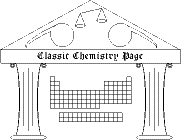Bodenstein equilibrium
Max Bodenstein made detailed measurements of the thermodynamics and kinetics of the gas-phase decomposition of hydrogen iodide
2 HI < --- > H2 + I2 .
His work, published in 1899, was one of the first such investigations over an extended temperature range. He heated HI samples, waiting for the decomposition reaction to come to equilibrium at several temperatures. He analyzed the equilibrium mixutures and reported the fraction of HI that decomposed. His data are reproduced below.
| temp (°C) | fraction decomposed, ξ
|
| 508 | 0.2408
|
| 487.2 | 0.2340
|
| 443 | 0.2198
|
| 427 | 0.2157
|
| 410 | 0.2100
|
| 393 | 0.2058
|
| 374 | 0.2010
|
| 356 | 0.1946
|
| 328 | 0.1885
|
| 302 | 0.1815
|
| 283 | 0.1787
|
(To download these data in a spreadsheet file, click here.)
1) The equilibrium constant is a function of the equilibrium pressures of the components,
K = pHpI/pHI2 .
Show that if the reaction mixture initially contained only HI at a pressure p, and if ξ denotes the fraction of HI that decomposed as the reaction proceded toward equilibrium, then the equilibrium constant can be expressed as
K = ξ2/[4(1 - ξ)2] .
2) Use the equation shown in exercise (1) to compute the equilibrium constant K at each temperature.
3) Make a van't Hoff plot (ln K vs. 1/T, where T is the absolute temperature) and report the best-fit straight line through the data. Use the plot to estimate the standard molar enthalpy and entropy changes (ΔH° and ΔS°) for the decomposition of HI.
Reference
Max Bodenstein, "Gas reactions in chemical kinetics II. Effect of the temperature on the formation and decomposition of hydrogen iodide," Zeitschrift für physikalische Chemie 29, 295-314 (1899)
Copyright 2003 by Carmen Giunta. Permission is granted to reproduce for non-commercial educational purposes.

| Back to the top of the Classic Chemistry site |